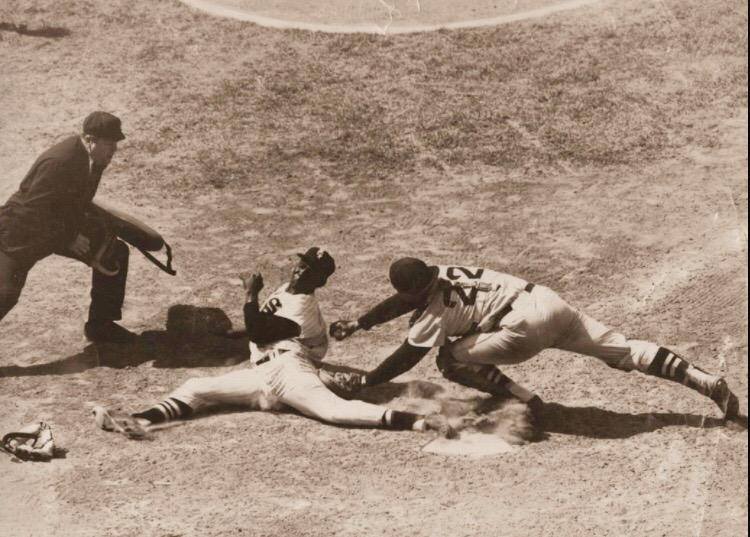Baseball History Comes Alive Now Ranked #2 by Feedspot Among All Internet Baseball History Websites and Blogs!
Guest Submissions from Our Readers Always Welcome!
Subscribe to my blog for automatic updates and Free Bonus Reports: “Memorable World Series Moments” and “Gary’s Handy Dandy World Series Reference Guide.”
Minnie Minoso Photo Gallery
Click on any image below to see photos in full size and to start Photo Gallery:
- Minnie Minoso with Latin White Sox teammates, Chico Carrasquel and Luis Aloma
- Minnie with the Minnie Minoso statue, 2004
- Two Chicago baseball legends: Ernie Banks and Minnie Minoso
- Minnie on right as member of the Black Cubans with teammate Lino Dinoso
- Minnie Minoso
- Minnie Minoso with the White Sox
- Minnie with White Sox owner, Bill Veeck
- Fan-favorite Minnie Minoso
- Minnie Minoso hook slides safely into home
- Minnie Minoso
- Another great slide into home plate
- Minnie Minoso with current White Sox Cuban star, Jose Abreu
- Minnie in Cleveland with “Trader” Frank Lane
- Minnie carries the White Sox World Series trophy with Luis Aparacio, Billy Pierce and Harold Baines
- Minnie throws out first pitch on St. Patrick’s day, March 17, 2001
Minnie Minoso’s “Grand” Return to the White Sox, 1960!
Opening Day at Comiskey Park, April 19, 1960 was a special day in White Sox history. The 1959 American League champions welcomed back fan-favorite Minnie Minoso after a three year exile to Cleveland. And what a “grand” return it was, as Minnie hit a fourth-inning grand slam and followed that with a ninth-inning walk-off home run to give the Sox a 10-9 victory over the Kansas City Athletics!
Check out the featured photo above. How’s that for a hook slide! The catcher is the Red Sox’ Sammy White.
Orestes “Minnie” Miñoso was one of the most popular players in White Sox history, helping the “Go-Go” White Sox become one of the premier teams of the 1950s and 1960s. A strong case can be made that Miñoso should be in the Hall of Fame. He played 17 seasons in the majors (1946-1980) for the Indians, White Sox, Cardinals and Senators. Over his career, he hit .298, with 1136 runs, 186 home runs, 1023 RBIs, 205 stolen bases, a .389 on-base percentage, and a .459 slugging average. His 130 OPS+ places well above average among his contemporaries.
Minnie was a seven-time All-Star (appearing in nine games), and a three-time Gold Glove winner. He was the first Black Cuban in the major leagues and the first black player in White Sox history. He began his professional career in 1946 with the Black Cubans, and was later signed by the Cleveland Indians in the wake of Jackie Robinson breaking the color barrier, appearing in nine games in 1949.
As a 1951 rookie, he hit .326, with 112 runs, 34 doubles, a league-leading 14 triples, 10 home runs, a league-leading 31 stolen bases, .422 on-base percentage, .500 slugging average, and was one of the first Latin Americans to play in the major league All-Star Game.
The “Cuban Comet” batted over .300 eight times. He was the American League leader in triples and stolen bases three times each and in hits, doubles, and total bases once each. He, along with Willie Mays, has been credited with leading the resurgence of speed as an offensive weapon in the 1950s. He also led the American League in times hit by pitch a record ten times, which contributed to his high career on-base percentage. Miñoso was a defensive standout and led left fielders in assists six times and in putouts and double plays four times each.
The White Sox in the 1950s were known for speed and defense, but Minoso was a rare power threat, holding the White Sox record for career home runs from 1956 to 1974 with 186. After his major league playing career was over in 1964, he went on playing and managing in Mexico through 1973. He rejoined the White Sox as a coach, and made brief but highly publicized player appearances in 1976 and 1980, becoming the third player to get a hit after the age of 50 and the second player to appear in the major leagues in five decades.
Minnie Miñoso’s White Sox uniform #9 was retired in 1983, and a statue of him was unveiled at U.S. Cellular Field in 2004. Miñoso was elected to the Cuban Baseball Hall of Fame in Exile in 1983, and to the Mexican Professional Baseball Hall of Fame in 1996.
Visit Our Web page: “Baseball History Comes Alive!
http://wp.me/P7a04E-2he
Gary Livacari
Photo Credits: All from Google search
Information: Excerpts edited from the Minnie Minoso Wikipedia page.
We are a participant in the Amazon Services LLC Associates Program, an affiliate advertising program designed to provide a means for us to earn fees by linking to Amazon.com and affiliated sites. Click here to view Amazon’s privacy policy

















Just wondering what leads you to believe that is Conlon in the photo. He was a National League umpire so it would be unusual if that did turn out to be him.
Good catch. Just thought it sort of looked like him, but you’re right…it can’t be him. Thanks.